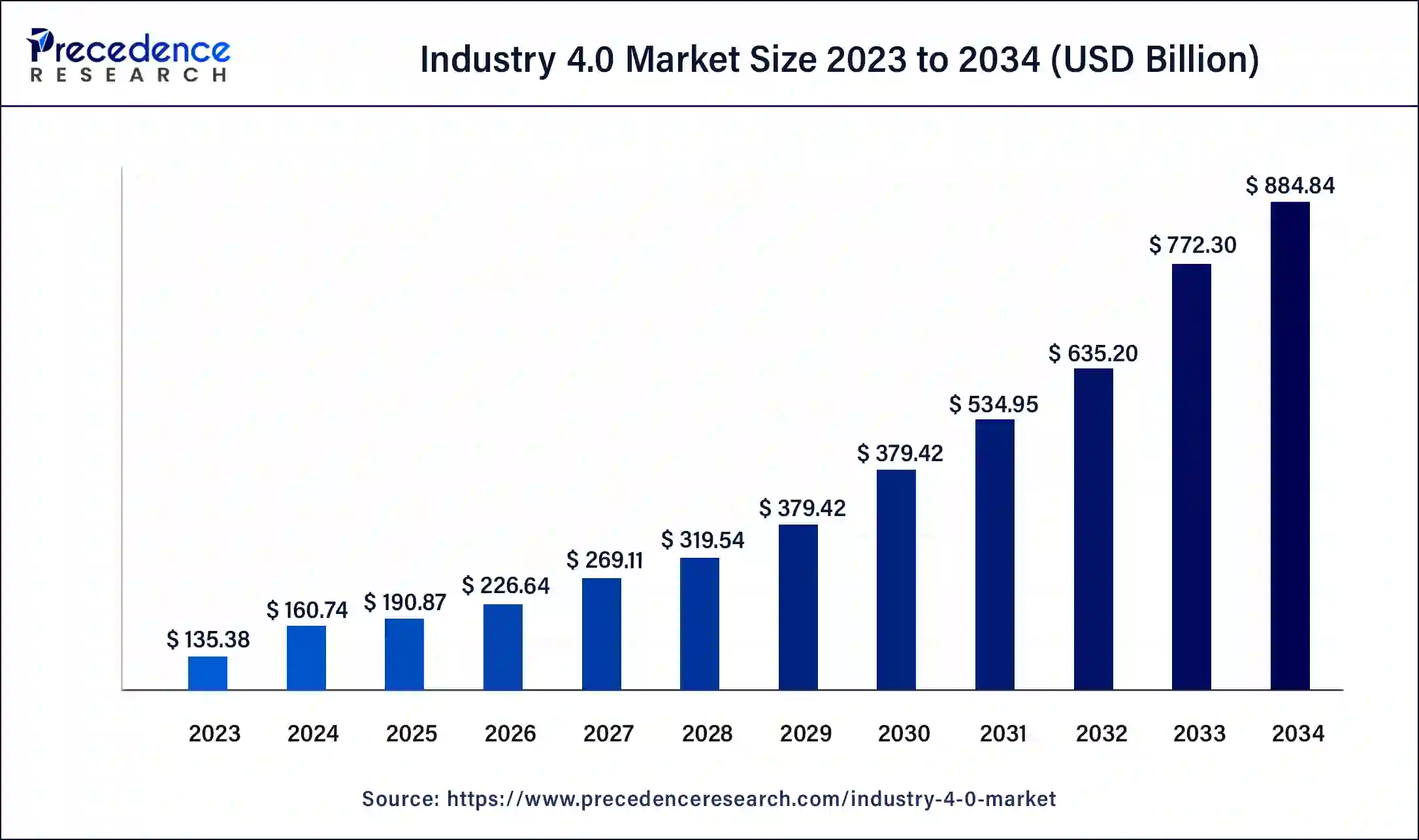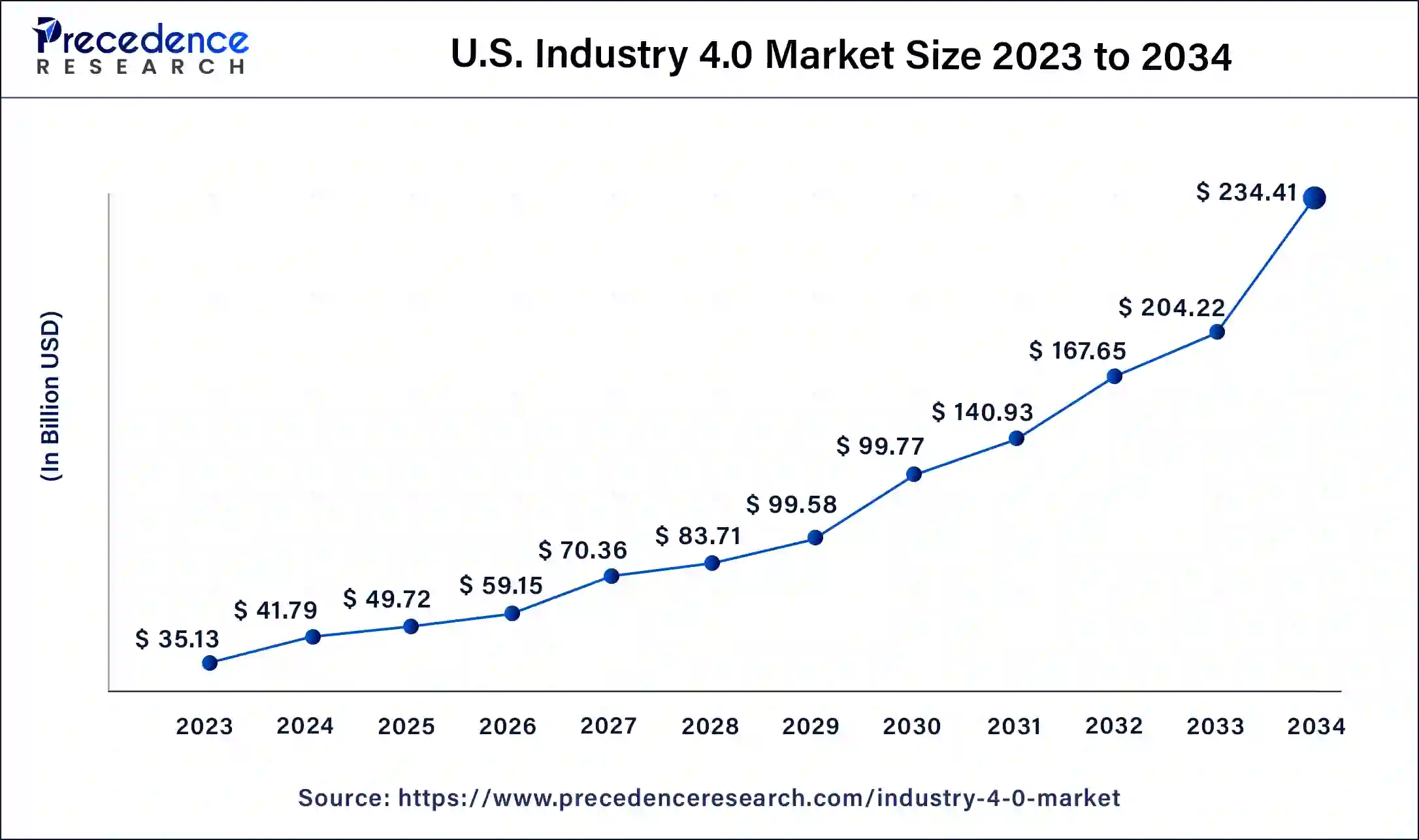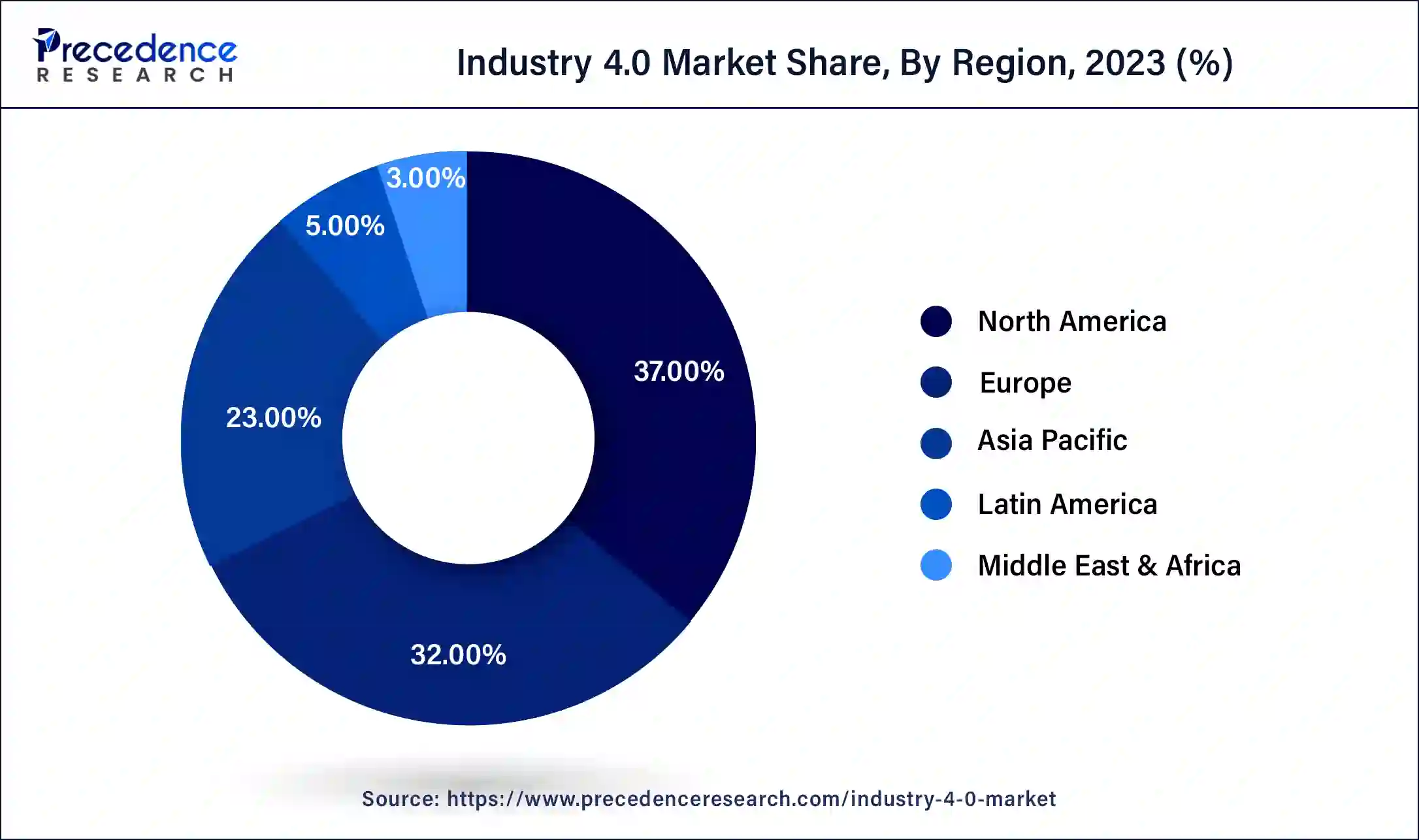August 2024
Industry 4.0 Market (By Technology Type: Industrial Internet of Things (IIoT), Extended Reality (XR), Block, Chain, Machine Learning (ML) and Artificial Intelligence (AI), Digital Twin, 3D Printing, Industry Automation, Others; By End-User: Aerospace and Defense, Food and Beverages, Energy and Utilities, Oil and Gas, Automotive, Manufacturing, Others) - Global Industry Analysis, Size, Share, Growth, Trends, Regional Outlook, and Forecast 2024-2034
The global Industry 4.0 market size was USD 135.38 billion in 2023, estimated at USD 160.74 billion in 2024 and is expected to reach around USD 884.84 billion by 2034, expanding at a CAGR of 18.6% from 2024 to 2034.

The U.S. industry 4.0 market size was valued at USD 35.13 billion in 2024 and is estimated to reach around USD 234.41 billion by 2034, growing at a CAGR of 18.8% from 2024 to 2034.

North America has held the largest revenue share in 2023. The region comprising the United States and Canada stands as a global leader in adopting and integrating advanced digital technologies across various industries. The Industry 4.0 market in North America owes its growth to several key drivers, including a thriving innovation ecosystem, vibrant startup culture, substantial investments in research and development, and a strong commitment towards technological advancements. Notably, tech hubs like Silicon Valley, Boston, and Austin have played instrumental roles in fostering innovation and nurturing Industry 4.0 technologies.
In these regions reside numerous startups alongside established tech giants, collectively driving the proliferation of cutting-edge solutions encompassing areas such as the Internet of Things (IoT), artificial intelligence (AI), and advanced manufacturing. Furthermore, North American governments display unwavering support for the advancement of Industry 4.0. They demonstrate their dedication through various means such as facilitating research grants, providing tax incentives, and implementing policies that foster digital transformation.

The Asia-Pacific Industry 4.0 market is a rapidly expanding and dynamic landscape that holds great promise and potential. China stands out as a manufacturing and technological powerhouse driving Industry 4.0 in Asia-Pacific. The country's "Made in China 2025" initiative sets ambitious goals to upgrade its manufacturing capabilities by integrating technologies such as IoT, AI, and automation. Chinese companies eagerly embrace these advancements to enhance production efficiency, product quality, and global competitiveness. Japan, known for its precision manufacturing and robotics expertise, has been at the forefront of embracing Industry 4.0 principles.
Japanese companies lead in developing cutting-edge robotics, automation solutions, and revolutionary IoT applications, playing a vital role in the regional landscape of Industry 4.0. Conversely, India is rapidly emerging as a prominent hub for IT and software services, crucial components of Industry 4.0 advancement. With its flourishing tech startup ecosystem fostering innovation in AI, data analytics, and IoT domains, Indian firms are successfully incorporating Industry 4.0 solutions into their operations and supply chains.
The industry 4.0 market signifies a groundbreaking shift in the manufacturing and industry landscape, often referred to as the fourth industrial revolution. The revolution of Industry 4.0 encompasses the integration of advanced digital technologies and traditional industrial processes. The convergence of the two forces is leading to a wave of disruptive innovations, including the Internet of Things (IoT), artificial intelligence (AI), machine learning, big data analytics, robotics and advanced automation systems.
In principle, Industry 4.0 aims to establish "smart factories" whereby machines, processes and products are working together and communicating with a minimal level of intervention by humans. By fostering interconnected systems, real-time data exchange, predictive maintenance capabilities, and swift decision-making become possible.
In the world of Industry 4.0, companies are heavily investing in optimizing production processes, cutting down on operational costs, improving product quality, and enhancing flexibility to meet market demands effectively. This transformation empowers the customization of products at a large scale, often coined as "batch size one," where production is tailored precisely according to individual customer requirements. Moreover, leveraging data-driven insights enables predictive maintenance practices for reducing downtime and maximizing overall equipment effectiveness.
Industry 4.0 is set to experience strong and consistent growth. This can be attributed to several factors that contribute to its widespread adoption and transformative impact across various sectors. One of the key drivers is the relentless pursuit of operational efficiency and productivity improvement. Companies are empowered by Industry 4.0 technologies such as automation, IoT sensors, AI, and advanced analytics.
These technologies allow for streamlining processes, reducing waste, and optimizing resource utilization, resulting in significant cost savings, increased output, and enhanced competitiveness. With modern supply chains becoming increasingly complex, Industry 4.0's expansion is further fueled. These technologies offer real-time visibility into supply chain operations, enhancing transparency, traceability, and responsiveness. These capabilities prove invaluable in mitigating risks, ensuring quality control, and meeting regulatory requirements. They enable companies to effectively overcome disruptions and uncertainties, as exemplified during the COVID-19 pandemic.
Therefore, the convergence of efficiency gains, customization demands, supply chain complexities, ongoing technological progress, innovation potential, and the global shift toward sustainability positions Industry 4.0 as a force that cannot be ignored in contemporary industry. It is transforming how businesses operate and deliver value, with expectations for its continuous growth and profound influence in the future.
| Report Coverage | Details |
| Market Size by 2032 | USD 884.84 Billion |
| Market Size in 2024 | USD 160.74 Billion |
| Market Size in 2023 | USD 135.38 Billion |
| Growth Rate from 2024 to 2033 | CAGR of 18.6% |
| Largest Market | North America |
| Base Year | 2023 |
| Forecast Period | 2024 to 2034 |
| Segments Covered | Technology Type, End-User, and Region |
| Regions Covered | North America, Europe, Asia-Pacific, Latin America, and Middle East & Africa |
Driver
Efficiency and productivity
In today's competitive business landscape, where companies face constant pressure to streamline operations and cut costs, Industry 4.0 technologies emerge as a game-changing solution. These groundbreaking tools encompass automation, IoT sensors, artificial intelligence, and advanced analytics, empowering businesses to optimize their processes with precision and intellect. One of the key advantages is a noticeable decrease in downtime and operational inefficiencies.
For instance, predictive maintenance leverages data analytics and IoT sensors to monitor machinery in real-time, enabling proactive maintenance actions before equipment failures occur. This not only minimizes expensive production stoppages but also extends the lifespan of critical assets. Another pivotal aspect is automation within Industry 4.0 which replaces labor-intensive tasks with autonomous systems, enhancing both production speed and accuracy in manufacturing processes. Robotics, equipped with AI algorithms, takes charge of repetitive tasks and ensures unparalleled consistency.
As a result, it leads to increased output and superior quality control. Furthermore, by incorporating data analytics, valuable insights into production bottlenecks and process optimization are gained. This allows for continuous improvement in operations. Reduced lead times and optimized resource utilization further enhance efficiency gains.
The drive for efficiency goes beyond the factory floor. Supply chains, which are crucial in many industries, benefit greatly from Industry 4.0's real-time visibility and predictive analytics. This allows companies to optimize inventory levels, swiftly respond to demand changes, and make well-informed decisions based on reliable data. Such a streamlined approach helps prevent delays, reduce costs, and minimize waste within the supply chain.
As the global market becomes more competitive and dynamic, efficiency and productivity are no longer just advantages but essential for business survival. With Industry 4.0, companies are equipped with the necessary tools to remain agile and responsive in rapidly changing environments. Furthermore, it enhances their ability to efficiently scale operations in order to meet growing demands.
Restraints
Complexity and integration challenges
Complexity and integration challenges hinder the growth of the Industry 4.0 market. This is due to the diverse nature of Industry 4.0 technologies, including IoT devices, data analytics platforms, and AI-driven systems. The implementation processes for these technologies can be intricate, posing hurdles for organizations. Moreover, legacy systems in many industries may not seamlessly integrate with modern technologies, leading to costly and time-consuming adaptations.
Ensuring interoperability among different devices and software solutions also presents a formidable task. To overcome these challenges, organizations must invest in specialized expertise such as system architects who can design integrated ecosystems and IT professionals who excel in managing data flows and connectivity.
Furthermore, integrating new processes can often disrupt ongoing operations. It requires meticulous planning and a strong commitment to minimizing potential downtime or inefficiencies. This challenge becomes particularly daunting for large-scale enterprises with entrenched systems. Consequently, many businesses encounter a steep learning curve and possible setbacks when transitioning to Industry 4.0, which can discourage adoption. To overcome these obstacles and fully unlock the transformative potential of Industry 4.0 while ensuring a smooth transition with minimal disruption, effective change management strategies and a strategic approach to integration are crucial.
Opportunities
Customization and personalization
In today's consumer-driven world, individuals are increasingly seeking products and experiences that cater to their unique preferences and needs. Thanks to Industry 4.0 technologies, businesses now have the power to deliver precisely that through a concept known as "mass customization." By combining the efficiency and scale of mass production with personalized choices, companies can offer a wide range of customized products. From tailor-made consumer electronics and clothing to individually crafted industrial equipment, manufacturers can meet diverse requirements.
The integration of IoT sensors allows gathering valuable data on customer preferences and usage patterns. This information is then translated into actionable insights through advanced AI and data analytics. Manufacturers now have the opportunity to design, assemble, and customize products according to their customers' specific needs. The level of personalization achieved today surpasses what was previously possible when relying solely on mass production techniques.
Additionally, incorporating personalization into business strategy can drive innovation. With the rise of Industry 4.0 and its powerful data generation capabilities, companies now have an unprecedented opportunity to delve deeper into customer behavior and market trends. This data-focused approach empowers them to develop innovative, personalized products and services, opening fresh revenue streams and captivating market prospects.
The ability to cater to individual preferences and deliver customized products and experiences drives the industry 4.0 market compellingly. Not only meets the demand of sophisticated consumers, but it also promotes innovation, improves customer loyalty and places businesses in a competitive position at a time when markets are rapidly evolving. In order to respond to the increasing need for personal services, more companies have begun adopting these technologies as they realize the potential of customization and personalization. The expansion of the industrial 4.0 market will be stimulated by this.
Impact of COVID-19
The COVID-19 pandemic unexpectedly but significantly benefited the Industry 4.0 market. As global supply chains faced disruptions, workforce limitations, and an increased need for remote operations, businesses turned to Industry 4.0 technologies as a crucial lifeline. Robotic process automation (RPA) and autonomous systems played a pivotal role in maintaining production levels while minimizing human contact and ensuring worker safety. Automation transformed from being merely convenient to becoming absolutely necessary, with autonomous guided vehicles in warehouses and robots on factory floors leading the way. Furthermore, the demand for remote monitoring and predictive maintenance solutions experienced a significant increase.
As a result of travel restrictions and social distancing measures, manufacturers actively sought ways to safeguard the wellbeing of their crucial equipment and mitigate expensive downtime. By harnessing IoT sensors and AI-driven analytics, they were empowered to monitor machinery in real-time, anticipate maintenance requirements, and resolve issues remotely. This advanced approach effectively reduced dependence on on-site personnel.
Furthermore, the pandemic expedited the digitization of supply chains. Businesses recognized the significance of having complete visibility and flexibility to navigate disruptions. This led to increased investments in digital solutions for supply chain management, including the utilization of blockchain technology for transparency and traceability, as well as AI-driven demand forecasting to effectively adapt to shifting consumer behavior.
Additionally, the shift towards remote work amplified the adoption of cloud-based systems and digital collaboration tools. Cloud computing played a pivotal role in Industry 4.0 by enabling secure data storage, processing, and sharing, allowing employees to access critical information from any location. As a result, productivity was enhanced while also facilitating remote decision-making.
According to the technology type, the industry automation sector has held the major revenue share in 2023. The industrial automation segment comprises various technologies and practices designed to streamline and optimize industrial processes, enhancing efficiency, productivity, and flexibility. A key component of this segment is the utilization of automation systems, including robots, robotic process automation (RPA), and autonomous machinery. These advanced technologies excel in executing repetitive tasks with precision and consistency, leading to reduced dependence on human labor, decreased errors, and improved overall production quality.
In addition, IoT sensors and devices gather real-time data from machinery and equipment, providing valuable insights into operational performance. Leveraging this data enables predictive maintenance wherein potential issues are identified proactively before they cause costly downtime. As a result, maintenance schedules become optimized while extending the lifespan of critical assets.
Moreover, the automation of industries heavily relies on artificial intelligence (AI) and machine learning algorithms to analyze the data gathered by IoT devices. These advanced technologies empower autonomous decision-making, optimize processes, and facilitate adaptive production. AI-driven systems have the capability to dynamically adjust manufacturing parameters, swiftly respond to market fluctuations, and streamline supply chain logistics.
The manufacturing sector had the highest market share on the basis of the end-user in 2023. The manufacturing industry, a prominent consumer of Industry 4.0 technologies, has undergone a significant transformation that gave birth to the era of intelligent and interconnected factories. With Industry 4.0 in mind, manufacturing encompasses diverse sectors ranging from automotive and aerospace to electronics, pharmaceuticals, and consumer goods. These sectors have enthusiastically embraced digital technology integration to optimize production processes, improve product quality, and achieve unparalleled levels of flexibility and efficiency.
Artificial intelligence (AI) and machine learning algorithms play crucial roles in this transformative journey for the manufacturing segment. AI-powered systems leverage vast datasets generated by IoT devices to uncover patterns, identify anomalies, and autonomously make decisions. This leads to more precise demand forecasting, optimized production schedules, enhanced quality control measures resulting in waste reduction and heightened productivity.
By Technology Type
By End-User
By Geography
For inquiries regarding discounts, bulk purchases, or customization requests, please contact us at sales@precedenceresearch.com
No cookie-cutter, only authentic analysis – take the 1st step to become a Precedence Research client
August 2024
July 2024
February 2025
July 2024